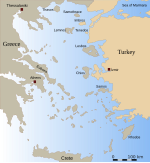Gramvousa
Gramvousa, also Grampousa (Greek: Γραμβούσα or Γραμπούσα, further names include Akra, Cavo Buso, Cavo Bouza, Garabusa and Grabusa), refers to two small uninhabited islands off the coast of a peninsula also known Gramvousa Peninsula (Greek: Χερσόνησος Γραμβούσας) in north-western Crete in the regional unit of Chania.
The fort remained in Venetian hands throughout the prolonged Cretan War, and in the treaty of 16 September 1669, which surrendered Crete to the Ottomans, Gramvousa, along with the fortresses of Souda and Spinalonga, was retained by Venice.
In 1823, Emmanouil Tombazis, the Greek provisional government's commissioner for Crete, failed to strengthen the defences at Gramvousa when he had the opportunity, soon after his arrival on the island.
On 9 August 1825, led by Dimitrios Kallergis and Emmanouil Antoniadis, this group of Cretans, disguised as Turks, captured the fort at Gramvousa, which became their base.
[11] During the Cretan revolt of 1878, only the forts at Gramvousa, Ierapetra, Spinalonga, Heraklion, Rethymnon, Izeddin, Hania, and Kissamos could not be captured by the insurgents because they did not have the necessary artillery.
North of Balos, at the Korykon cape, are the ruins of the small ancient Roman city of Agnion, with a temple to the god Apollo.



